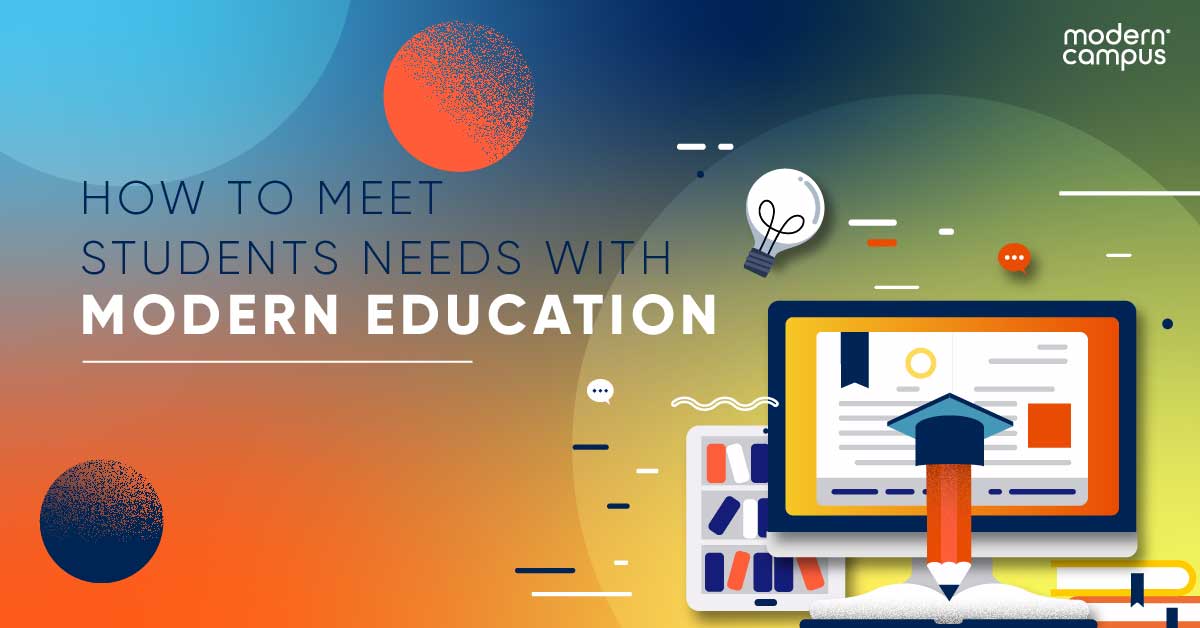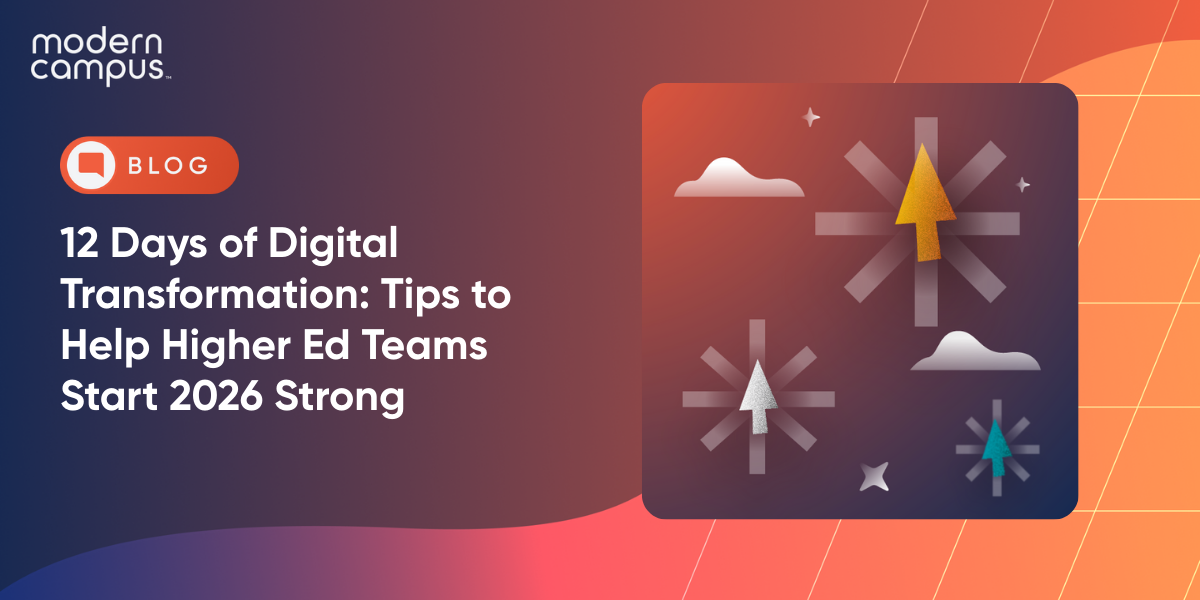Modern Education: Ultimate Guide to Meet Students' Needs
Today’s students no longer fit the mold of an 18-22 year old fresh out of high school. They are non-traditional, and want to set the terms of their experience. Personalization and customization are demanded of their institution.
They want to enjoy a modern education experience that matches what they expect from the consumer world. This consumer mindset they bring to the table is forcing colleges and universities to change the way they operate to create a modern education system.
What is Modern Education?
Simply put, the purpose of modern education is to prepare students for the realities of today's workforce by providing them learning experiences. And the characteristics of modern education need to reflect the same consumer experience learners get in their everyday lives.
According to Ruffalo Noel Levitz’s 2019 report on Adult Student Satisfaction and Priorities, non-traditional students don’t have any patience for “the run-around” from their college or university. They expect seamless processes, contextual service, and constant access to information. When an institution can’t deliver on these expectations, it significantly impacts student satisfaction.
Advantages of Modern Education
The impact of modernization in education can have a ripple effect. For Marie Cini—former provost of academic affairs at the University of Maryland University College (UMUC)—they saw the effect of this first hand.
Cini and the team at UMUC were trying to understand why they weren’t achieving a full graduation rate. After all, they’re an online institution designed specifically to serve adult students. After conducting internal research, they found that the customer experience played a significant role in student retention.
“We lose them when they’ve had approximately three problems with administrative bureaucracy,” she said. “If they call about financial aid and they don’t get an answer they understand, and then they stop in, and they try to enroll with a face-to-face advisor, and then they’re not given accurate information, and then one other thing occurs, they leave us. We know that’s an incredible impact on student’s retention and success.”
Challenges While Engaging the Modern Learner
Oftentimes, most of the challenges in education today begin with engaging the modern learner. Higher education providers of all sizes are challenged by an engagement gap between their offerings, services and experiences, and the expectations of modern learners.
However, there are a few major warning signs leaders should be on the lookout for:
1. Your Relationship with Students is Transactional
Is your relationship with students transactional? You’ll know it is if you’re focused on students enrolling in one-time programs where they earn a single credential and then progress to “alumni”—whose engagement with the institution is limited to donations and occasional football games.
Transactional student relationships happen when colleges don’t proactively encourage students to continue coming back for upskilling, reskilling, and ongoing learning across their lifetime. This kind of persistent access supports career development and growth. Importantly: it places your institution as the hub for a student’s lifelong learning… not just the place where they learned how to be an adult!
2. You Don't Offer the Digital Experience Students Expect
An engagement gap between your institution and your learners will definitely emerge if you lack a digital engagemenet infrastructure that meets students where they are.
That’s a lot of jargon, so let’s break that idea down. Do your students have no choice but to call, fax, or come to the campus to conduct basic tasks like registering for courses, accessing their transcript, or getting information? Or are you leveraging any technological advancement you can? Are you able to offer them an Amazon-like shopping experience? Does your website feed them relevant programs, services, or offerings so they don’t have to dig? Are you suggesting related courses or programs that might interest them?
If you answered “no” to any of those questions, you have low digital engagement with students. This will especially come out if you look at performance stats around web conversions and they’re low, or if your shopping cart abandonment rates are high.
By making it easy for students to see how your institution addresses their needs, you’ll more clearly stand out as the learning provider for them!
3. You're Seeing Dips in Enrollment Numbers
Enrollment growth is a priority for every higher education provider of every description. For some schools, enrollment numbers are critical for financial stability. For others, they’re central to ensuring the mission of the institution is being met.
In either case, those numbers are increasingly difficult to meet. The marketplace for every kind of student enrollment—whether you’re focused on degree programming, non-credit courses or workforce training—is highly-competitive and crowded. But the fact is… there’s growing demand for education programming (as long as it meets the expectations of the learner!).
If your institution is still suffering to bring people in the door, it’s essential to look into why. Maybe you’re not offering a diverse enough set of credentials to meet students where they are. Maybe your website makes it impossible for prospective students to see what you’re actually offering. Maybe your alumni engagement tactics need to be updated.
In either case, demand for ongoing education suggests that no school should be dealing with enrollment declines. Addressing the gap between learner expectations and institutional engagement will help bridge that divide if you’re experiencing this challenge.
4. You Don't Identify Clear Pathways to Work
Students want to see clear connections between their education and labor market outcomes. This kind of visibility right from the start of their engagement with you helps keep them on track through their programs, and also supports their outcomes and direction after they graduate.
For some educational institutions, career pathways are embedded at the core of their program offerings using pathways software—to the extent that career and salary information is displayed right on the program page! But for others, career support only goes as far as Career Advising Services, which students need to manually book appointments to visit, and appointment booking is restricted to specific hours on specific days.
Unfortunately, if students are progressing toward a credential but don’t know what it’s going to get them—or the jobs and salary they’re preparing themselves for—it sets them up for underemployment at graduation (if they even get that far).
You know you have a learn-work disconnect if students struggle to get career advising, if they lack digital badges that help communicate specific skills and competencies, and if they don’t have a clear sense of how their credential connects to a career. This is an absolutely essential gap for higher education leaders to address.
How to Modernize Your Higher Ed Shopping Cart?
Most higher education registration systems are designed to be iterative, not innovative. That means they were built to digitize paper and pencil processes, instead of actually taking advantage of being digital assets.
That means your institution is probably making students jump through all kinds of hoops to get what they’re looking for. And that’s your best-case scenario!
“The harder we make it for students to jump through our hoops to get to their goals,
the more likely they’re going to leave and choose another institution for their educational
needs.”
Lesley Nichols | Executive Director of Professional Studies, Emerson College
Students today think and act like customers. Modern education teaching methods have to start with a next-gen system in place. Without it, prospective students will give up on your website and seek out a digital experience that more closely matches their expectations.
Education in the modern era begins with improving the digital experience. Here are some ways to modernize your student experience:
1. Reduce Dropoff: Why Your System Isn't Bringing Students Through
Examples of modern technology in education begin with a registration system. Most systems expect everyone to go through the same process; the student comes to the website, they add an offering to the cart, and then they check out.
Three steps. That’s it. 1-2-3.
The problem is, there’s a whole world of people out there and a whole range of pathways and experiences that your next-gen system is probably missing.
Today’s online shopping environment is incredibly complex. Today’s consumer is looking for an experience that is tailored and personalized.
Your registration needs to deliver on both.
“We could improve the student enrollment registration experience by modeling it off
of similar features in Amazon.”
Emily Joy Bembeneck | Associate Director of Pedagogical Innovation in the Graham School
of Continuing Liberal and Professional Studies, University of Chicago
2. Meet Expectations: The Need for a Next-Gen System
A modern registration system should make the most of being a digital asset. It should deliver more than just an online shopping cart—can people find what they’re looking for?
Your next-gen system needs to provide search engine optimization for your website.
The website has to be easy for students to navigate. They need to be able to browse programs, certificates, courses, and badges to find what’s right for them. For those who know what they want, you need to offer an advanced search that helps them to find it quickly and easily.
From either step, students then expect to arrive at a landing page for their selected offering that provides the information they need to make an informed buying decision.
“A superior user experience can help universities attract learners to their programs
and provide an education that is conducive to learners’ needs and lives.”
Quentin Ruiz-Esparza | Associate Director of Online Duke, Duke University
3. Improve Automation: Making Life Easier for Prospects
So many factors go into the decision whether to run a particular course or program (check out this exec guide for more on that). But just because something’s not being offered right now doesn't mean people aren’t looking for it!
If a student gets to your offering landing page, but the course they want isn’t being offered, what does your registration system do?
More than likely, it suggests students come back later. Do you really think—in a market with over 8,000 competitors—the prospective student is going to put an alert on their phone to navigate back to your website?
Clearly not. You need to make it easy for them.
Your next-gen system needs to provide Remind-Me functionalities when a program isn’t available, and automate your waitlist if it’s full.
That way, when the course or spot opens up, the system automatically notifies the right people.
The more technology you can leverage to simplify the education shopping experience, the better.
“After Destiny One sent the automated emails for the first time, 25 percent of the
recipients signed up for courses right away.”
Carolyn Young | Director of Continuing Studies, Western University
4. Enhance Your Cart: Digital Shopping in the New Age
There is no reason for a digital shopping cart to be static, but in most higher education registration systems, that’s all it is. The shopping cart does nothing more than collect offerings and allow students to process payments.
But it can be so much more! Think about your Amazon shopping cart. It:
- Provides visual cues to remind you what you’re purchasing.
- Allows you to input discount codes and shows you, right on screen, your adjusted price.
- Saves items for later, so you don’t lose the products that interest you.
- Reminds you when you’ve left things in your shopping cart, so you can come back and make the purchase.
- Sticks with your account, so when you add items to your cart on your phone, you can see those same items when you log in on your computer.
A next-gen registration system should also do all of these things. Education and modern technologies don’t have to be separate. You should be offering your prospective students that exact engagement—because it’s what they expect.
And it makes a difference in the dollars and cents, too. Through the abandoned shopping cart recovery feature, Modern Campus customers generated an average revenue boost of 17% in a single year!
5. Stop Playing Checkers: The Market Is Playing Chess
Destiny One is the next-gen system you need to expand your reach. Your traditional registration system just doesn't cut it anymore.
The system streamlines and simplifies the registration process to deliver a checkout experience built on eCommerce best practices. But it also does so much more… because it’s a next-gen system!
It makes your website findable from search engines and easy to navigate. That way, prospective students can find you, and then easily find the offerings that suit them best.
Then, it makes the website work for the student by providing the information they need to progress through to check out. It even automates waitlist and reminder functions to make sure they can access the offering later if it’s unavailable.
Finally, it puts the shopping cart to work—taking it from a static piece of code to a living engagement mechanism that’s persistent and impactful.
How to Meet the Student’s Needs?
Students are looking for the same modern experience from their postsecondary institution that they get from every other customer engagement. After all, they’re not interested in why information might be harder to share in a postsecondary environment. Understanding the importance of modern education starts with that modern experience.
If you’re not using a next-gen system, it’s time to put your registration system to work for you!
Applying Student Lifecycle Management Fundamentals to Higher Education
Learn how postsecondary institutions can create a positive experience across the learner lifecycle.
Last updated: May 29, 2023




